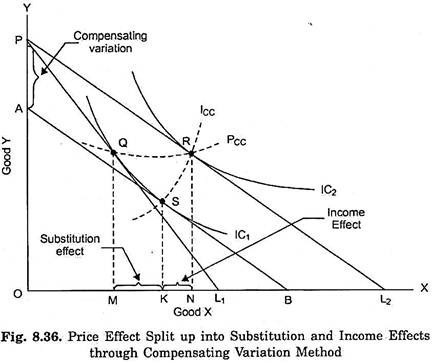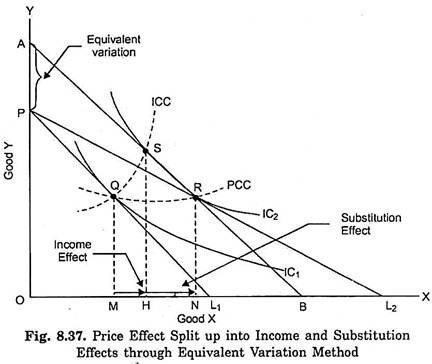How the price effect can be decomposed into income effect and substitution effect is is explained by the methods below:
1. Decomposing Price Effect: Compensating Variation in Income:
In the method of decomposing price effect by compensating variation we adjust the income of the consumer so as to offset the change in satisfaction and bring the consumer back to his original indifference curve, that is, his initial level of satisfaction which he was obtaining before the change in price occurred.
For instance, when the price of a commodity falls and consumer moves to a new equilibrium position at a higher indifference curve his satisfaction increases. To offset this gain in satisfaction resulting from a fall in price of the good we must take away from the consumer enough income to force him to come back to his original indifference curve.
ADVERTISEMENTS:
This required reduction in income (say, through levying a lump sum tax) to cancel out the gain in satisfaction or welfare occurred by reduction in price of a good is called compensating variation in income. This is so called because it compensates (in a negative way) for the gain in satisfaction resulting from a price reduction of the commodity. How the price effect is decomposed into substitution effect and income effect is illustrated in Fig. 8.36.
When the price of good X falls and as a result budget line shifts to PL2, the real income of the consumer rises, i.e., he can buy more of both the goods with his given money income. That is, price reduction enlarges consumer’s opportunity set of the two goods. With the new budget line PL2 he is in equilibrium at point R on a higher indifference curve IC2 and thus gains in satisfaction as a result of fall in price of good X.
Now, if his money income is reduced by the compensating variation in income so that he is forced to come back to the indifference curve IC1 as before, he would buy more of X since X has now become relatively cheaper than before. In Fig. 8.36 as result of the fall in price of X, price line switches to PL2.
ADVERTISEMENTS:
Now, with the reduction in income by compensating variation, budget line shifts to AB which has been drawn parallel to PL2 so that it just touches the indifference curve ICX where he was before the fall in price of X. Since the price line AB has got the same slope as PL2, it represents the changed relative prices with X relatively cheaper than before.
Now, X being relatively cheaper than before, the consumer in order to maximize his satisfaction in the new price-income situation substitutes X for Y. Thus, when the consumer’s money income is reduced by the compensating variation in income (which is equal to PA in terms of Y or L2B in terms of X), the consumer moves along the same indifference curve IC, and substitutes X for Y with price line AB, he is in equilibrium at S on indifference curve IC, and is buying MK more of X in place of Y.
This movement from Q to S on the same indifference curve IC, represents the substitution effect since it occurs due to the change in relative prices alone, real income remaining constant. If the amount of money income which was taken away from him is now given back to him, he would move from S on indifference curve IC, to R on a higher indifference curve IC2.
The movement from S on a lower indifference curve to R on a higher indifference curve is the result of income effect. Thus the movement form Q to R due to price effect can be regarded as having been taken place into two steps first from Q to S as a result of substitution effect and second from S to R as a result of income effect. In is thus manifest that price effect is the combined result of a substitution effect and an income effect.
ADVERTISEMENTS:
In Fig. 8.36 the various effects on the purchases of good X are:
Price effect = MN
Substitution effect = MK
Income effect = KN
MN = MK + KN
Or Price effect = Substitution effect + Income effect.
From the above analysis, it is thus clear that price effect is the sum of income and substitution effects.
2. Decomposing Price Effect: Equivalent Variation in Income:
Price effect can be split up into substitution and income effects through an alternative method of equivalent variation in income. The reduction in price of a commodity increases consumer’s satisfaction as it enables him to reach a higher indifference curve.
ADVERTISEMENTS:
Now, the same increase in satisfaction can be achieved through bringing about an increase in his income, prices remaining constant. This increase in income of the consumer prices of goods remaining the same, so as to enable him to move to a higher subsequent indifference curve at which he in fact reaches with reduction in price of a good is called equivalent variation in income because it represents the variation in income that is equivalent in terms of gain in satisfaction to a reduction in price of the good.
Thus, in this equivalent income-variation method substitution effect is shown along the subsequent indifference curve rather than the original one. How this price effect is decomposed into income and substitution effects through equivalent variation in income is shown in Fig. 8.37.
When the price of good X falls, the consumer can purchase more of both the goods, that is, the purchasing power of his given money income rises. It means that after the fall in price of X, if the consumer buys the same quantities of goods as before, then some amount of money will be left over. In other words, the fall in price of good X will release sonic amount of money. Money thus released can be spent on purchasing more of both the goods.
ADVERTISEMENTS:
It therefore follows that a change in price of the good produces an income effect. When the power to purchase goods rises due to the income effect of the price change, or in other words, when some amount of money is released as a result of the fall in price, the consumer has to decide how this increase in his purchasing power is to be spared over the two goods he is buying. How he will spread the released purchasing power over the two goods depends upon the nature of his income consumption curve which in turn is determined by his preferences about the two goods.
From above it follows, that, as a result of the increase in his purchasing power (or real income) due to the fall in price, the consumer will move to a higher indifference curve and will become better off than before. It is as if the price had remained the same but his money income was increased. In other words, a fail in the price of good X does to the consumer what an equivalent rise in money income would have done to him.
As a result of fall in price of X, the consumer can therefore be imagined as moving up to a higher indifference curve along the income consumption curve as if his money income has increased, prices of X and Y remaining unchanged. Thus, a given change in price can be thought of as an equivalent to an appropriate change in income.
It will be seen from Fig. 8.37 that with price line PL1, the consumer is in equilibrium at Q on indifference curve IC1. Suppose price of good X falls, price of Y remaining unaltered, so that budget line is now PL2. With budget line PL2, he is in equilibrium at R on indifference curve ICZ. Now, a line AB is drawn parallel to PL1 so that it touches the indifference curve IC2 at S.
ADVERTISEMENTS:
It means that the increase in real income or purchasing power of the consumer as a result of the fall in price of X is equal to PA in terms of Y or LXB in terms of X. Movement of the consumer from Q on indifference curve IC, to S on higher indifference curve IC2 along the income consumption curve is the result of income effect of the price change. But the consumer will not be finally in equilibrium at S.
This is because now that X is relatively cheaper than 1′; he will substitute X, which has become relatively cheaper, for good Y, which has become relatively dearer. It will be a profitable thing for the consumer to do so. Thus the consumer will move along the indifference curve IC2 from S to R.
This movement from S to R has taken place because of the change in relative prices alone and therefore represents substitution effect. Thus the price effect can be resolved into income and substitution effects, showing in this case substitution along the subsequent indifference curve.
In Fig 8.37 the magnitudes of the various effects are:
Price effect = MN
Income = MH
ADVERTISEMENTS:
Substitution effect = MH
In Fig. 8.37, MH = MH + HN
Or Price effect = Income Effect + Substitution Effect
Advantage of Breaking Up Price Effect into Income and Substitution Effects:
A distinct advantage of viewing the price effect as a sum of income effect and substitution effect is that through it the nature of response of quantity purchased to a change in the price of a good can be better and easily explained. In case of most of the goods, the income effect and substitution effect work in the same direction. But, in some cases, they may pull in different directions.
The direction of substitution effect is quite certain. A fall in the relative price of a good always leads to the increase in quantity demanded of the good. In other words, substitution effect always induces the consumer to buy more of the cheaper good. But the direction of income effect is not so certain.
ADVERTISEMENTS:
With a rise in income, the individual will generally buy more of a good. But with the rise in income the individual will buy less of a good if it happens to be an inferior good for him since he will use better or superior substitutes in place of the inferior good when his income rises.
Thus the income effect may be either positive or negative. If for a good the income effect is positive, as is usually the case, it will act in the same direction as the substitution effect, that is, both will work towards increasing the quantity demanded of the good whose price has fallen. For the inferior good in which case income effect is negative, income effect of the price change will work in opposite direction to the substitution effect.
The net effect of the price change will then depend upon the relative strengths of the two effects. To sum up, price effect is composed of income effect and substitution effect and further that the direction in which quantity demanded will change as a result of the fall in price will depend upon the direction and strength of the income effect on the one hand and strength of the substitution effect on the other.

